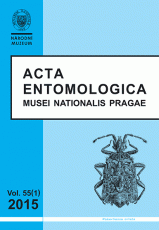Description of the larval stages of the berosine genera Berosus and Regimbartia based on the Japanese species B. japonicus and R. attenuata (Coleoptera: Hydrophilidae)
Minoshima Yusuke, Hayashi Masakazu
Acta Entomologica Musei Nationalis Pragae 55(1): 47-83, 2015
Published in print: 1st June 2015
Views: 1204
Abstract: Larval morphology and head chaetotaxy are described for two genera of the tribe
Berosini, Berosus Leach, 1817 and Regimbartia Zaitzev, 1908, based on reared
and field-collected larvae of Berosus (Berosus) japonicus Sharp, 1873 and
Regimbartia attenuata (Fabricius, 1801). We describe and illustrate the general
morphology and head chaetotaxy of all three instars of both species. We review
and discuss an ecological character, which is an adaptation to benthic lifestyle
in Berosus. Berosus larvae do not have air-bubbles in alimentary canal, whereas
majority of hydrophilid larvae have air-bubbles. Absence of the bubbles results
in loss of buoyancy and would be an adaptation in two different ecological
trends: benthic and swimming lifestyles. A detailed comparison of head
chaetotaxy of both genera is provided. Chaetotaxy of Berosus and Regimbartia are
not largely different, therefore benthic lifestyle will not strongly affect
chaetotaxy. We also provide information of knowledge about immature stages of
the tribe Berosini and provide the identification key to larvae of all five
genera of the tribe. Biology of both studied species is briefly commented
as well.
Key words: Coleoptera, Hydrophilidae, larva, Berosus, Regimbartia, Berosini, Hydrophilinae, chaetotaxy, Japan, Palaearctic
Papers
In memoriam RNDr. Vladimír Švihla, CSc.Description of a new genus and species of Hemisphaeriini from Brunei with an identification key to the Bornean species of the tribe (Hemiptera: Fulgoroidea: Issidae)Cicadatra pazukii, a new cicada species, with an identification key to the species of Cicadatra in Iran (Hemiptera: Cicadidae)Parahiranetis salgadoi, a new genus and species of Harpactorini (Hemiptera: Heteroptera: Reduviidae), with a key to Neotropical wasp-mimicking harpactorine generaThe genus Nematopus (Hemiptera: Heteroptera: Coreidae) of French Guiana with a description of one new speciesDescription of the larval stages of the berosine genera Berosus and Regimbartia based on the Japanese species B. japonicus and R. attenuata (Coleoptera: Hydrophilidae)Review of the subgenus Attumbrinus (Coleoptera: Leiodidae: Cholevinae: Philomessor), with description of Philomessor lackneri sp. nov. from MoroccoTen new species of cavernicolous Tribasodites from China and Thailand, and a list of East Asian cave-inhabiting Pselaphinae (Coleoptera: Staphylinidae)Notes on Scaphisoma of Kalimantan (Coleoptera: Staphylinidae: Scaphidiinae)Osoriinae of Cuba with description of new species and an identification key (Coleoptera: Staphylinidae)Larvae of Australian Buprestidae (Coleoptera). Part 5. Genera Astraeus and Xyroscelis, with notes on larval characters of Australian polycestine taxaRevision of the Neotropical genus Pseudodira (Coleoptera: Coccinellidae: Epilachnini)A review of the genera Indostola, Tagenostola, Indochillus, Pseudethas, and Pseudochillus gen. nov. in South East Asia (Coleoptera: Tenebrionidae: Stenosini)A new species of the genus Synchroa from Taiwan, with a key to the world fauna (Coleoptera: Synchroidae)Studies of the genus Anthelephila (Coleoptera: Anthicidae) 13. The species described by W. W. Saunders from IndiaNew Bruchidius species reared from Vachellia (Fabaceae: Mimosoideae: Acacieae) seeds from Eastern and Southern Africa (Coleoptera: Chrysomelidae: Bruchinae)Revision of western Palaearctic species of the Oulema melanopus group, with description of two new species from Europe (Coleoptera: Chrysomelidae: Criocerinae)Nomenclature and taxonomy of the genus Stylops (Strepsiptera): an annotated preliminary world checklistAn updated checklist of Dryinidae, Embolemidae and Sclerogibbidae (Hymenoptera) of Kenya and Burundi, with descriptions of thirteen new speciesNeotype designation and redescription of Camponotus horseshoetus (Hymenoptera: Formicidae)Two new genera of Keroplatidae (Diptera), with an updated key to the World genera of KeroplatiniGenus Sciapus (Diptera: Dolichopodidae) in Iran, with description of one new species and new recordsCatalogue of the type specimens of true bugs (Hemiptera: Heteroptera) deposited in the National Museum, Prague, Czech Republic. Pentatomomorpha: Aradidae 